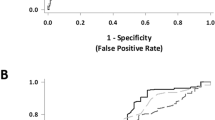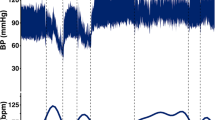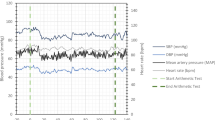Abstract
Study Design
Secondary analysis of a clinical trial.
Objective
To assess the impact of 6 months of arm cycle ergometry training (ACET), or body weight-supported treadmill training (BWSTT), on autonomic cardiovascular responses to a laboratory sit-up test (SUT) in individuals with chronic (≥1-year post-injury) spinal cord injury (SCI).
Setting
Tertiary Rehabilitation Centre, Vancouver, Canada.
Methods
Sixteen individuals with motor-complete (American Spinal Injury Association Impairment Scale A-B) SCI between the fourth cervical and sixth thoracic spinal cord segments, aged 39 ± 11 years, were assessed. Participants were randomized to receive 72 sessions of moderate-to-vigorous intensity ACET (n = 8) or passive BWSTT (n = 8). Changes in mean arterial pressure (finger plethysmography), hemodynamics (Modelflow® method), and heart rate/heart rate variability (HR/HRV; electrocardiography) were measured in response to a SUT before and after 6 months of exercise training. Spontaneous cardiovagal baroreflex sensitivity (cvBRS) was assessed using the sequence method.
Results
Neither ACET nor BWSTT impacted hemodynamic responses to SUT or the incidence of orthostatic hypotension (all P > 0.36). ACET increased HR (P < 0.01, ηp2 = 0.34) and high frequency (HF) power HRV responses (P < 0.01, ηp2 = 0.42) to SUT following 6 months of training while BWSTT did not. Consistent with this, cvBRS improved (P < 0.05, ηp2 = 0.16) only following ACET. Improvements in cvBRS were correlated with both the HR (r = 0.726, P < 0.0001) and HF power (r = −0.484, P < 0.01) responses to SUT.
Conclusion
Six months of ACET, but not BWSTT, improved cardiovagal baroreflex control of HR but had no effect on BP responses to SUT in individuals with chronic, motor-complete SCI.
Sponsorship
Canadian Institutes of Health Research (CIHR)
Clinical Trial Registration
NCT01718977
This is a preview of subscription content, access via your institution
Access options
Subscribe to this journal
Receive 12 print issues and online access
269,00 € per year
only 22,42 € per issue
Buy this article
- Purchase on SpringerLink
- Instant access to full article PDF
Prices may be subject to local taxes which are calculated during checkout



Similar content being viewed by others
Data availability
The data supporting the findings of this study are available from the corresponding author upon reasonable request.
References
Phillips AA, Krassioukov AV, Ainslie PN, Warburton DE. Baroreflex function after spinal cord injury. J Neurotrauma. 2012;29:2431–45.
Cragg JJ, Noonan VK, Krassioukov A, Borisoff J. Cardiovascular disease and spinal cord injury: results from a national population health survey. Neurology. 2013;81:723–8.
Laterza MC, de Matos LD, Trombetta IC, Braga AM, Roveda F, Alves MJ, et al. Exercise training restores baroreflex sensitivity in never-treated hypertensive patients. Hypertension. 2007;49:1298–306.
Monahan KD, Dinenno FA, Tanaka H, Clevenger CM, DeSouza CA, Seals DR. Regular aerobic exercise modulates age-associated declines in cardiovagal baroreflex sensitivity in healthy men. J Physiol. 2000;529:263–71.
Madden KM, Lockhart C, Potter TF, Cuff D. Aerobic training restores arterial baroreflex sensitivity in older adults with type 2 diabetes, hypertension, and hypercholesterolemia. Clin J Sport Med. 2010;20:312–7.
Martin Ginis KA, van der Scheer JW, Latimer-Cheung AE, Barrow A, Bourne C, Carruthers P, et al. Evidence-based scientific exercise guidelines for adults with spinal cord injury: an update and a new guideline. Spinal Cord. 2018;56:308–21.
Chiou SY, Clarke E, Lam C, Harvey T, Nightingale TE. Effects of arm-crank exercise on fitness and health in adults with chronic spinal cord injury: a systematic review. Front Physiol. 2022;13:831372.
Nightingale TE, Walhin JP, Thompson D, Bilzon JLJ. Impact of exercise on cardiometabolic component risks in spinal cord-injured humans. Med Sci Sports Exerc. 2017;49:2469–77.
Solinsky R, Draghici A, Hamner JW, Goldstein R, Taylor JA. High-intensity, whole-body exercise improves blood pressure control in individuals with spinal cord injury: a prospective randomized controlled trial. PLoS ONE. 2021;16:e0247576.
Ditor DS, Macdonald MJ, Kamath MV, Bugaresti J, Adams M, McCartney N, et al. The effects of body-weight supported treadmill training on cardiovascular regulation in individuals with motor-complete SCI. Spinal Cord. 2005;43:664–73.
Ditor DS, Kamath MV, MacDonald MJ, Bugaresti J, McCartney N, Hicks AL. Effects of body weight-supported treadmill training on heart rate variability and blood pressure variability in individuals with spinal cord injury. J Appl Physiol. 2005;98:1519–25.
Claydon VE, Steeves JD, Krassioukov A. Orthostatic hypotension following spinal cord injury: understanding clinical pathophysiology. Spinal Cord. 2006;44:341–51.
Carter JB, Banister EW, Blaber AP. Effect of endurance exercise on autonomic control of heart rate. Sports Med. 2003;33:33–46.
Xu D, Wang H, Chen S, Ross S, Liu H, Olivencia-Yurvati A, et al. Aerobic exercise training improves orthostatic tolerance in aging humans. Med Sci Sports Exerc. 2017;49:728–35.
Krassioukov AV, Currie KD, Hubli M, Nightingale TE, Alrashidi AA, Ramer L, et al. Effects of exercise interventions on cardiovascular health in individuals with chronic, motor complete spinal cord injury: protocol for a randomised controlled trial [Cardiovascular Health/Outcomes: Improvements Created by Exercise and education in SCI (CHOICES) Study]. BMJ Open. 2019;9:e023540.
Kirshblum SC, Burns SP, Biering-Sorensen F, Donovan W, Graves DE, Jha A, et al. International standards for neurological classification of spinal cord injury (revised 2011). J Spinal Cord Med. 2011;34:535–46.
Reference Values for Arterial Stiffness C. Determinants of pulse wave velocity in healthy people and in the presence of cardiovascular risk factors: ‘establishing normal and reference values’. Eur Heart J. 2010;31:2338–50.
Harkema SJ, Ferreira CK, van den Brand RJ, Krassioukov AV. Improvements in orthostatic instability with stand locomotor training in individuals with spinal cord injury. J Neurotrauma. 2008;25:1467–75.
Alrashidi AA, Nightingale TE, Currie KD, Hubli M, MacDonald MJ, Hicks AL, et al. Exercise improves cardiorespiratory fitness, but not arterial health, after spinal cord injury: the CHOICES trial. J Neurotrauma. 2021;38:3020–9.
Currie KD, Wong SC, Warburton DE, Krassioukov AV. Reliability of the sit-up test in individuals with spinal cord injury. J Spinal Cord Med. 2015;38:563–6.
Dorey TW, O’Brien MW, Robinson SA, Kimmerly DS. Knee-high compression socks minimize head-up tilt-induced cerebral and cardiovascular responses following dynamic exercise. Scand J Med Sci Sports. 2018;28:1766–74.
Harms MP, Wesseling KH, Pott F, Jenstrup M, Van Goudoever J, Secher NH, et al. Continuous stroke volume monitoring by modelling flow from non-invasive measurement of arterial pressure in humans under orthostatic stress. Clin Sci. 1999;97:291–301.
Heart rate variability: standards of measurement, physiological interpretation and clinical use. Task Force of the European Society of Cardiology and the North American Society of Pacing and Electrophysiology. Circulation 1996;93:1043–65.
Parati G, Saul JP, Di Rienzo M, Mancia G. Spectral analysis of blood pressure and heart rate variability in evaluating cardiovascular regulation. A critical appraisal. Hypertension. 1995;25:1276–86.
Dorey TW, O’Brien MW, Kimmerly DS. The influence of aerobic fitness on electrocardiographic and heart rate variability parameters in young and older adults. Auton Neurosci. 2019;217:66–70.
Dorey TW, Walter M, Krassioukov AV. Reduced reflex autonomic responses following intradetrusor OnabotulinumtoxinA Injections: a pre-/post-study in individuals with cervical and upper thoracic spinal cord injury. Front Physiol. 2021;12:796277.
Shaffer F, Ginsberg JP. An overview of heart rate variability metrics and norms. Front Public Health. 2017;5:258.
Zhang R, Iwasaki K, Zuckerman JH, Behbehani K, Crandall CG, Levine BD. Mechanism of blood pressure and R-R variability: insights from ganglion blockade in humans. J Physiol. 2002;543:337–48.
Parati G, Di Rienzo M, Mancia G. How to measure baroreflex sensitivity: from the cardiovascular laboratory to daily life. J Hypertens. 2000;18:7–19.
Parlow J, Viale JP, Annat G, Hughson R, Quintin L. Spontaneous cardiac baroreflex in humans. Comparison with drug-induced responses. Hypertension. 1995;25:1058–68.
O’Brien MW, Johns JA, Dorey TW, Frayne RJ, Fowles JR, Mekary S, et al. Meeting international aerobic physical activity guidelines is associated with enhanced cardiovagal baroreflex sensitivity in healthy older adults. Clin Auton Res. 2020;30:139–48.
Lakens D. Calculating and reporting effect sizes to facilitate cumulative science: a practical primer for t-tests and ANOVAs. Front Psychol. 2013;4:863.
La Rovere MT, Pinna GD. Beneficial effects of physical activity on baroreflex control in the elderly. Ann Noninvasive Electrocardiol. 2014;19:303–10.
Winker R, Barth A, Bidmon D, Ponocny I, Weber M, Mayr O, et al. Endurance exercise training in orthostatic intolerance: a randomized, controlled trial. Hypertension. 2005;45:391–8.
Ray CA, Hume KM. Sympathetic neural adaptations to exercise training in humans: insights from microneurography. Med Sci Sports Exerc. 1998;30:387–91.
Smit AA, Halliwill JR, Low PA, Wieling W. Pathophysiological basis of orthostatic hypotension in autonomic failure. J Physiol. 1999;519:1–10.
Alajam R, Alqahtani AS, Liu W. Effect of body weight-supported treadmill training on cardiovascular and pulmonary function in people with spinal cord injury: a systematic review. Top Spinal Cord Inj Rehabil. 2019;25:355–69.
Vivodtzev I, Taylor JA. Cardiac, autonomic, and cardiometabolic impact of exercise training in spinal cord injury: a qualitative review. J Cardiopulm Rehabil Prev. 2021;41:6–12.
Ormezzano O, Cracowski JL, Quesada JL, Pierre H, Mallion JM, Baguet JP. EVAluation of the prognostic value of BARoreflex sensitivity in hypertensive patients: the EVABAR study. J Hypertens. 2008;26:1373–8.
La Rovere MT, Specchia G, Mortara A, Schwartz PJ. Baroreflex sensitivity, clinical correlates, and cardiovascular mortality among patients with a first myocardial infarction. A prospective study. Circulation. 1988;78:816–24.
Deley G, Picard G, Taylor JA. Arterial baroreflex control of cardiac vagal outflow in older individuals can be enhanced by aerobic exercise training. Hypertension. 2009;53:826–32.
Soriano JE, Romac R, Squair JW, Barak OF, Sarafis ZK, Lee AHX, et al. Passive leg cycling increases activity of the cardiorespiratory system in people with tetraplegia. Appl Physiol Nutr Metab. 2022;47:269–77.
Mesbah S, Legg Ditterline B, Wang S, Wu S, Weir J, Wecht J et al. Novel clinimetric toolset to quantify the stability of blood pressure and its application to evaluate cardiovascular function after spinal cord injury. Front Anal Sci. 2021;1:701891.
Hutchinson MJ, Goosey-Tolfrey VL. Rethinking aerobic exercise intensity prescription in adults with spinal cord injury: time to end the use of “moderate to vigorous” intensity? Spinal Cord. 2022;60:484–90.
Acknowledgements
The authors would like to thank all participants for their commitment in this study and the assistance of numerous volunteers during exercise training sessions. We acknowledge the support of Dr. Leanne Ramer (Simon Fraser University) in helping with writing and submitting the trial protocol. We also appreciate the support of Dr. Robert Teasel (University of Western Ontario) as a chair of Data and Safety Monitoring Committee for the CHOICES trial. We also gratefully acknowledge the administrative support of study coordinators at ICORD/UBC: Andrea Ramirez, Dr. Cameron Gee, Marko Gavric and Martina Franz in helping with participants’ screening, assessments, and training.
Funding
This work was supported by the Canadian Institutes of Health Research (CIHR) project grant (TCA 118348), Canada Foundation for Innovation (CFI) and BC Knowledge Development Fund (BCKDF 35869) awarded to AVK. TWD was supported by a CIHR Doctoral Research Award (412708). TEN was funded by the Michael Smith Foundation for Health Research and International Collaboration on Repair Discoveries (ICORD) Research Trainee Award (17767). ST was supported by a UBC work learn position. AAA was supported for his PhD scholarship by King Fahad Medical City, Riyadh, Saudi Arabia. KDC was funded by a Postdoctoral Fellowship from the Heart and Stroke Foundation (17R26776) and Craig H. Neilson Foundation (281863). MH was funded by two fellowships from the Swiss National Science Foundation for Prospective Researchers (PBEZP3_145704 and P300P3_151153). SJTB was supported by the Robert H.N. Ho Scholarship. AVK holds an Endowed Chair in Spinal Cord Rehabilitation Research, Department of Medicine, UBC.
Author information
Authors and Affiliations
Contributions
TWD, TEN, and ST were responsible for data analysis and interpretation. TEN, AAA, KDC, MH, and SJTB were responsible for collection of the data and revising the manuscript for intellectual content. TWD and TEN prepared the figures and wrote the manuscript. AVK was responsible for study concept/design, managing data collection at the Vancouver center, and revising the manuscript for intellectual content. All authors approved the final version of this manuscript.
Corresponding author
Ethics declarations
Competing interests
The authors declare no competing interests.
Ethics approval and consent to participate
We certify that all applicable and governmental regulations concerning the ethical use of human volunteers were followed during the course of this research. Written informed consent was obtained from all participants. This study was performed in line with the principles of the Declaration of Helsinki. This study has received approval from the University of British Columbia Research Ethics Board; approval number H12-02945.
Additional information
Publisher’s note Springer Nature remains neutral with regard to jurisdictional claims in published maps and institutional affiliations.
Rights and permissions
Springer Nature or its licensor (e.g. a society or other partner) holds exclusive rights to this article under a publishing agreement with the author(s) or other rightsholder(s); author self-archiving of the accepted manuscript version of this article is solely governed by the terms of such publishing agreement and applicable law.
About this article
Cite this article
Dorey, T.W., Nightingale, T.E., Alrashidi, A.A. et al. Effects of exercise on autonomic cardiovascular control in individuals with chronic, motor-complete spinal cord injury: an exploratory randomised clinical trial. Spinal Cord 62, 597–604 (2024). https://doi.org/10.1038/s41393-024-01019-z
Received:
Revised:
Accepted:
Published:
Issue Date:
DOI: https://doi.org/10.1038/s41393-024-01019-z



